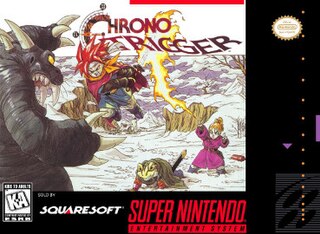
Chrono Trigger is a 1995 role-playing video game developed and published by Square. It was originally released for the Super Nintendo Entertainment System as the first entry in the Chrono series. The game's development team included three designers that Square dubbed the "Dream Team": Hironobu Sakaguchi, creator of Square's Final Fantasy series; Yuji Horii, creator of Enix's Dragon Quest series; and Akira Toriyama, character designer of Dragon Quest and author of the Dragon Ball manga series. In addition, Takashi Tokita co-directed the game and co-wrote the scenario, Kazuhiko Aoki produced the game, while Masato Kato wrote most of the story. The game's plot follows a group of adventurers who travel through time to prevent a global catastrophe.
Final Fantasy is a fantasy anthology media franchise created by Hironobu Sakaguchi which is owned, developed, and published by Square Enix. The franchise centers on a series of fantasy role-playing video games. The first game in the series was released in 1987, with 16 numbered main entries having been released to date.
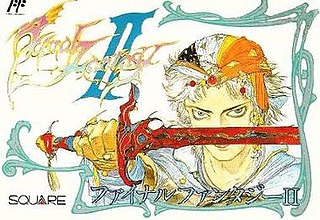
Final Fantasy II is a fantasy role-playing video game developed and published by Square in 1988 for the Family Computer as the second installment of the Final Fantasy series. The game has received numerous enhanced remakes for the WonderSwan Color, the PlayStation, the Game Boy Advance, the PlayStation Portable, iOS, Android and Windows. As neither this game nor Final Fantasy III were initially released outside Japan, Final Fantasy IV was originally released in North America as Final Fantasy II, so as not to confuse players. Following enhanced versions for iOS and Android in 2010 and 2012 respectively, the game was re-released again as part of the 2021 Final Fantasy Pixel Remaster series.

Final Fantasy IV, titled Final Fantasy II in its initial North American release, is a role-playing video game developed and published by Square for the Super Nintendo Entertainment System. Released in 1991, it is the fourth main installment of the Final Fantasy series. The game's story follows Cecil, a dark knight, as he tries to prevent the sorcerer Golbez from seizing powerful crystals and destroying the world. He is joined on this quest by a frequently changing group of allies. Final Fantasy IV introduced innovations that became staples of the Final Fantasy series and role-playing games in general. Its "Active Time Battle" system was used in five subsequent Final Fantasy games, and unlike prior games in the series, IV gave each character their own unchangeable character class — although at a few points in the story, a dark knight will choose the path of a paladin, or a summoner will evolve to a new tier of spellcasting.
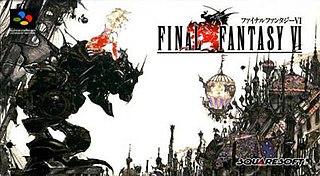
Final Fantasy VI, also known as Final Fantasy III from its initial North American release, is a 1994 role-playing video game developed and published by Square for the Super Nintendo Entertainment System. It is the sixth main entry in the Final Fantasy series, the final to feature 2D sprite based graphics, and the first to be directed by someone other than series creator Hironobu Sakaguchi; the role was instead filled by Yoshinori Kitase and Hiroyuki Ito. Long-time collaborator Yoshitaka Amano returned as character designer and concept artist, while composer Nobuo Uematsu returned to compose the game's score, which has been released on several soundtrack albums.

Final Fantasy V is a fantasy role-playing video game developed and published by Square in 1992. It is the fifth main installment of the Final Fantasy series. The game first appeared only in Japan on Nintendo's Super Famicom. It has been ported with minor differences to Sony's PlayStation and Nintendo's Game Boy Advance. An original video animation produced in 1994 called Final Fantasy: Legend of the Crystals serves as a sequel to the events depicted in the game. It was released for the PlayStation Network on April 6, 2011, in Japan. An enhanced port of the game, with new high-resolution graphics and a touch-based interface, was released for iPhone and iPad on March 28, 2013, for Android on September 25 the same year and for Windows on September 24, 2015. A more enhanced re-release of the game as part of the Final Fantasy Pixel Remaster series, was released on November 10, 2021 for Android, iOS, and Windows, and for Nintendo Switch and PlayStation 4 on April 19, 2023.

Final Fantasy III is a role-playing video game developed and published by Square for the Family Computer. The third installment in the Final Fantasy series, it is the first numbered Final Fantasy game to feature the job-change system. The story revolves around four orphaned youths drawn to a crystal of light. The crystal grants them some of its power, and instructs them to go forth and restore balance to the world. Not knowing what to make of the crystal's pronouncements, but nonetheless recognizing the importance of its words, the four inform their adoptive families of their mission and set out to explore and bring back balance to the world.

The Mana series, known in Japan as Seiken Densetsu, is a high fantasy action role-playing game series created by Koichi Ishii, with development formerly from Square, and is currently owned by Square Enix. The series began in 1991 as Final Fantasy Adventure, a Game Boy handheld side story to Square's flagship franchise Final Fantasy. The Final Fantasy elements were subsequently dropped starting with the second installment, Secret of Mana, in order to become its own series. It has grown to include games of various genres within the fictional world of Mana, with recurring stories involving a world tree, its associated holy sword, and the fight against forces that would steal their power. Several character designs, creatures, and musical themes reappear frequently.

Itadaki Street is a party video game series originally created by Dragon Quest designer Yuji Horii. It is currently owned by Square Enix. The first game was released in Japan on Nintendo's Famicom console in 1991. Since then, new installments in the series have been released for the Super Famicom, PlayStation, PlayStation 2, PlayStation Portable, Nintendo DS, Mobile Phones, Android, iOS, PlayStation 4 and PlayStation Vita. The series was exclusive to Japan prior to the 2011 Itadaki Street Wii, which is released as Fortune Street in North America and Boom Street in Europe.

Dragon Quest IV: Chapters of the Chosen, titled Dragon Warrior IV when initially localized to North America, is a role-playing video game, the fourth installment of the Dragon Quest video game series developed by Chunsoft and published by Enix, and the first of the Zenithian Trilogy. It was originally released for the Famicom on 11 February 1990 in Japan. A North American NES version followed in October 1992, and would be the last Dragon Quest game localized and published by Enix's Enix America Corporation subsidiary prior to its closure in November 1995, as well as the last Dragon Quest game to be localized into English prior to the localization of Dragon Warrior Monsters in December 1999. The game was remade by Heartbeat for the PlayStation, which eventually was available as an Ultimate Hits game. The remake was ported by ArtePiazza to the Nintendo DS, released in Japan November 2007 and worldwide in September 2008. A mobile version based on the Nintendo DS remake was released in 2014 for Android and iOS.

Final Fantasy Legend II, known in Japan as SaGa 2: Hihou Densetsu, is a role-playing video game developed and published by Square for the Game Boy. The second entry in the SaGa series, it was released in 1990 in Japan, and in 1991 in North America. A remake for the Nintendo DS was released in 2009 by Square Enix, remaining exclusive to Japan. The Game Boy version was later ported to the Nintendo Switch and released worldwide by Square Enix in 2020, with later ports to Android, iOS and Microsoft Windows in 2021.

Final Fantasy Legend III, known in Japan as SaGa 3: Jikuu no Hasha, is a role-playing video game developed and published by Square for the Game Boy. The third entry in the SaGa series, it was released in Japan in 1991 and in North America in 1993. A remake for the Nintendo DS was released in 2011 by Square Enix, remaining exclusive to Japan. The Game Boy version was later ported to the Nintendo Switch and released worldwide by Square Enix in 2020, with later ports to Android, iOS and Microsoft Windows in 2021.
The Chrono series is a video game franchise developed and published by Square, and is currently owned by Square Enix. The series began in 1995 with the time travel role-playing video game Chrono Trigger, which spawned two continuations, Radical Dreamers: Nusumenai Hōseki, and Chrono Cross. A promotional anime called Dimensional Adventure Numa Monjar and two ports of Chrono Trigger were also produced. As of March 31, 2003, Chrono Trigger was Square Enix's 12th best-selling game, with 2.65 million units shipped. Chrono Cross was the 24th, with 1.5 million units shipped. By 2019, the two games had sold over 5.5 million units combined. The games in the series have been called some of the greatest of all time, with most of the praise going towards Chrono Trigger. The series' original soundtracks, composed by Yasunori Mitsuda, have also been praised, with multiple soundtracks being released for them.

Final Fantasy Crystal Chronicles: Ring of Fates is an action role-playing game for the Nintendo DS, developed and published by Square Enix. It is a prequel to Final Fantasy Crystal Chronicles for the GameCube. The game takes advantage of both the local wireless and Wi-Fi capabilities of the system and features voice acting.
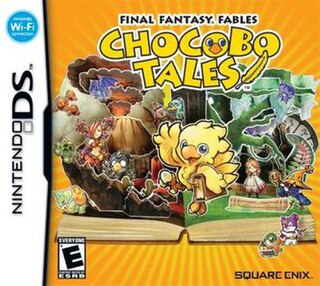
Final Fantasy Fables: Chocobo Tales, released in Japan as Chocobo to Mahō no Ehon is a Nintendo DS adventure game developed by h.a.n.d. and published by Square Enix. It was released in Japan on December 14, 2006, in North America on April 3, 2007, and in the PAL region in May.

Final Fantasy Tactics A2: Grimoire of the Rift is a tactical role-playing game developed and published by Square Enix for the Nintendo DS handheld game console. Releasing in 2007 in Japan and 2008 in the West, the game is a sequel to Final Fantasy Tactics Advance and forms part of the Ivalice Alliance, a group of games set in the titular fictional universe. The game features cameo appearances from central and supporting characters from Final Fantasy XII, a title set in Ivalice.
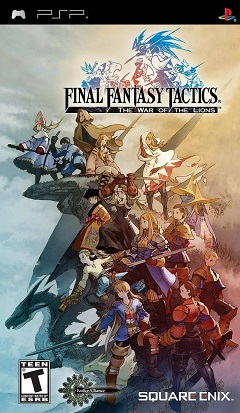
Final Fantasy Tactics: The War of the Lions is a tactical role-playing game developed and published by Square Enix for the PlayStation Portable (PSP). The game is an updated version of Final Fantasy Tactics made for the PlayStation, which was released in 1997.
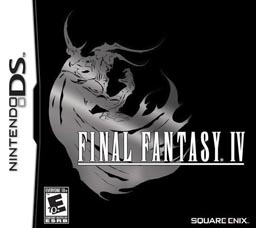
Final Fantasy IV is a Nintendo DS role-playing video game and a remake of the 1991 SNES game, Final Fantasy IV, also known as Final Fantasy II in North America for the SNES. It was released as part of the Final Fantasy series 20th anniversary celebrations on December 20, 2007 in Japan, on July 22, 2008 in North America, and on September 5 in Europe.

Final Fantasy Fables: Chocobo's Dungeon is a 2007 role-playing video game published by Square Enix for the Wii. It is an installment in the Chocobo series that focuses on Chocobo and his quest to free a town lost in time from eternal forgetfulness. It is a loose sequel to Chocobo's Dungeon 2 on the PlayStation.

Final Fantasy is a fantasy role-playing video game developed and published by Square in 1987. It is the first game in Square's Final Fantasy series, created by Hironobu Sakaguchi. Originally released for the NES, Final Fantasy was remade for several video game consoles and is frequently packaged with Final Fantasy II in video game collections. The first Final Fantasy story follows four youths called the Warriors of Light, who each carry one of their world's four elemental crystals which have been darkened by the four Elemental Fiends. Together, they quest to defeat these evil forces, restore light to the crystals, and save their world.




















